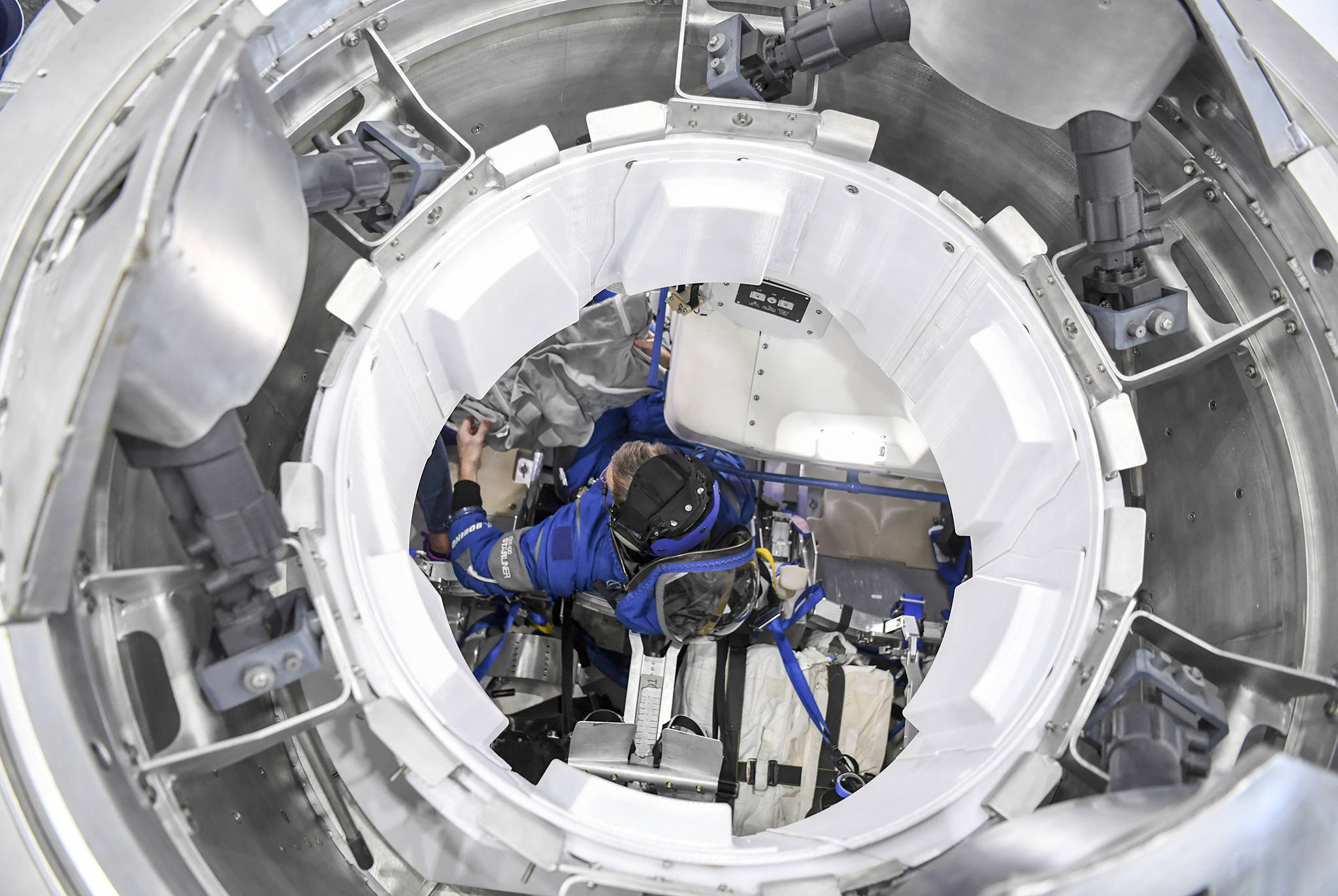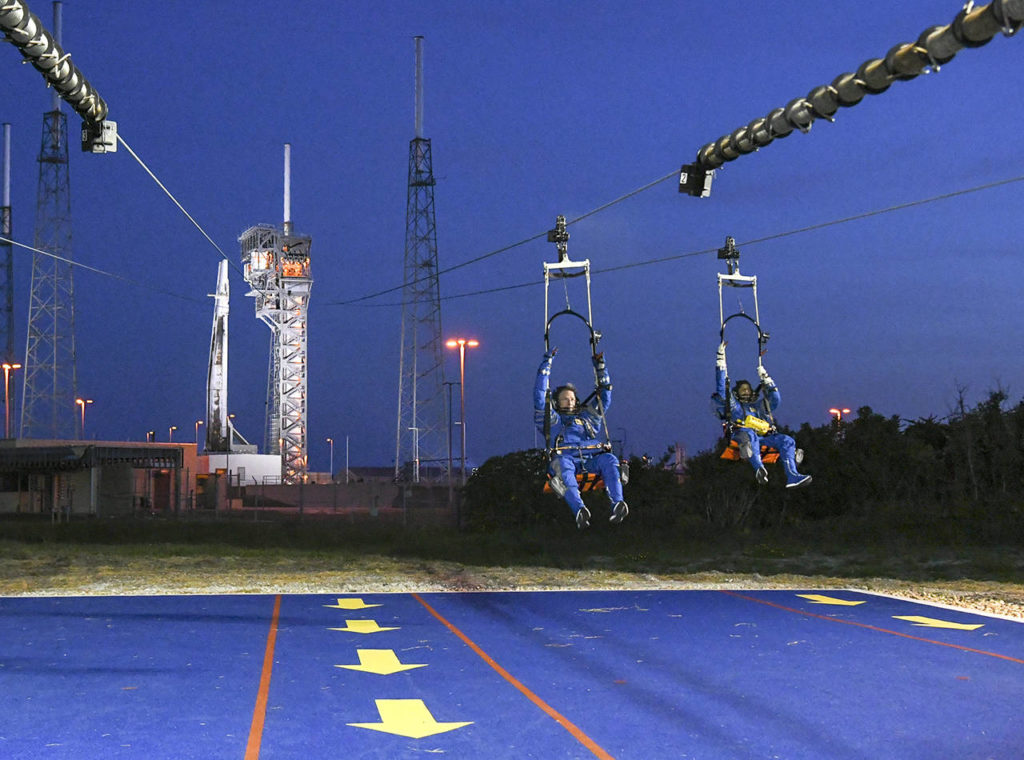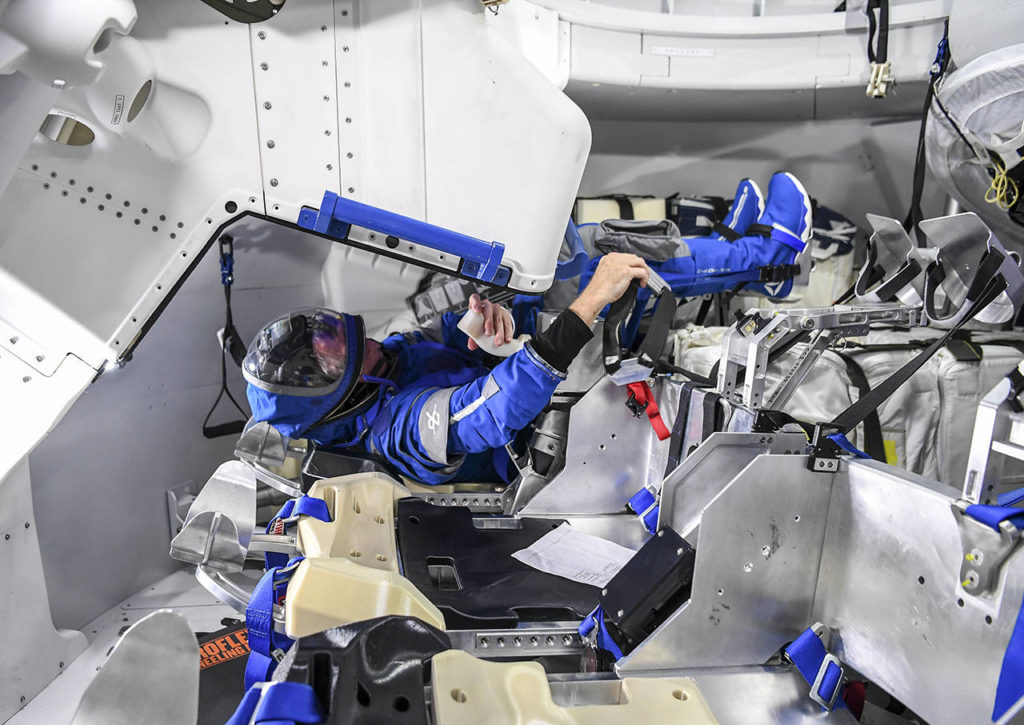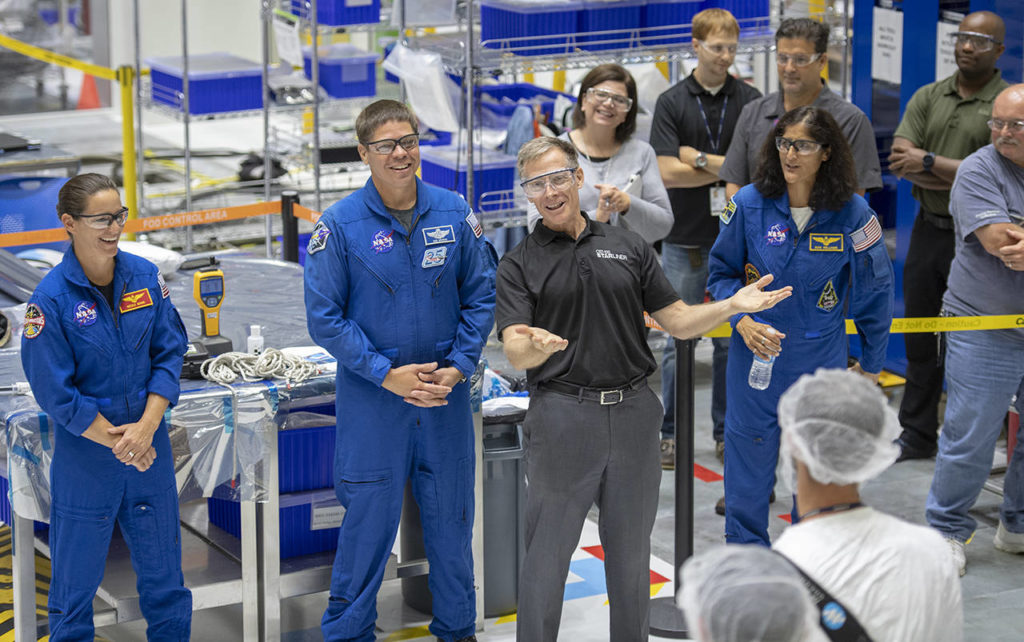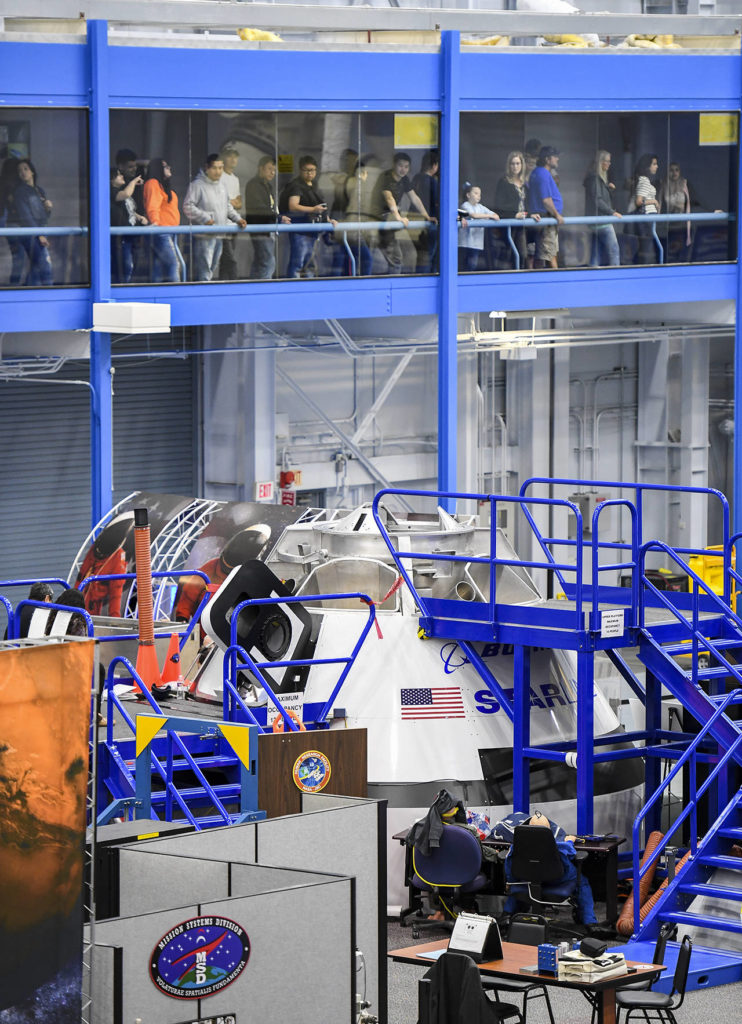By Christian Davenport / The Washington Post
HOUSTON — He still looks every bit the NASA astronaut he once was. Same chest-out posture. Same Top Gun instincts. Same American flag on the left shoulder of his flight suit. Chris Ferguson even has a call sign, “Fergy.”
There is one small detail that sets Ferguson apart from the NASA astronauts he is training alongside. Where they have the space agency’s red-white-and-blue logo on their spacesuits, he wears Boeing’s corporate insignia — a small accessory that symbolizes what the space agency hopes is a new era in space travel.
Ferguson retired from NASA after serving as the commander of the last space shuttle mission in 2011. Today, he’s a corporate astronaut who is hoping to make history as the first private citizen to launch to orbit on a commercially operated rocket.
As a test pilot of the inaugural flight of Boeing’s Starliner spacecraft, he would serve alongside NASA’s astronauts. But NASA hopes his presence on the mission to the International Space Station augurs a long-awaited next chapter in America’s human spaceflight program, one where commercial ventures have ended the government’s long-held monopoly in space with the hope of making it accessible to civilians.
NASA has been unable to fly people from U.S. soil since the shuttle was retired. Since then, its astronauts have flown to the space station on Russian rockets from a Soviet-era launch site in Kazakhstan. In 2014, NASA awarded contracts worth a combined $6.8 billion to Boeing and SpaceX to develop spacecraft that would finally restore human spaceflight from the Florida Space Coast.
The space agency, which has wanted to fly ordinary people since the early days of the space shuttle, hopes that by hiring the companies to provide a sort of taxi service to the space station they would also carry all sorts of passengers to orbit.
In the contracts, NASA included a provision that allows Boeing and SpaceX to sell tickets to fly ordinary people, even tourists, on the NASA missions — civilian astronauts whom the companies would train and then fly to the station, where they would spend a week or so living in space.
“We wanted to basically enable a new market,” said Phil McAlister, the director of NASA’s commercial spaceflight division. “We wanted these companies to have the ability to sell their services to nongovernmental customers… . NASA has always had a desire to open up spaceflight to a broader audience.”
That is also SpaceX’s goal.
“Human spaceflight is the core mission of our company — to help create a future where millions of people are out exploring the stars and living on other planets,” Gwynne Shotwell, SpaceX’s president and chief operating officer, said in a statement to The Washington Post.
Gathered in the Roosevelt Room of the White House in 1985, Vice President George H.W. Bush said he was pleased to announce “the first private citizen in the history of space flight.” It was Christa McAuliffe, a 36-year-old high school social studies teacher from Concord, New Hampshire, who promised to keep a journal of her in time in orbit just as “the pioneer travelers of the Conestoga wagon days” had.
NASA had won the Cold War space race to the moon and was now aiming to make space travel routine with its space shuttle, a winged space plane that was supposed to fly affordably — and eventually take all sorts to space.
NASA was already eyeing its next big program — flying a journalist, a contest that had drawn interest from some of the biggest names in the news industry, including Walter Cronkite.
“In time, poets, painters, laborers, musicians and others will get to fly,” the New York Times reported.
And then, 73 seconds after the space shuttle Challenger lifted off, it exploded, killing McAuliffe and the six other passengers.
The Teacher in Space program was effectively canceled (though McAuliffe’s backup, Barbara Morgan, eventually flew on the shuttle in 2007). There was no journalist in space. After the shuttle Columbia came apart in 2003, again killing all seven on board, NASA began to wind down the shuttle program.
But now, a growing commercial space industry, fueled in large part by the finances of several billionaire entrepreneurs, is pushing ahead, undaunted.
Despite never flying a single human being anywhere, Elon Musk, the founder of SpaceX, talks of colonizing Mars and says his company will eventually fly two paying tourists on a trip around the moon. While flying NASA’s astronauts remains the company’s top priority, it also plans to “begin flying missions for private citizens,” Shotwell said. In addition to the lap around the moon, she said the company is about to sign another deal to fly private citizens, though she declined to provide details.
Jeff Bezos’ Blue Origin hopes to fly customers past the edge of space on suborbital jaunts within a year or so. (Bezos owns The Washington Post.) So does Richard Branson’s Virgin Galactic, which has persevered even after a co-pilot was killed when its space plane came apart during a test flight in 2014.
Even Boeing, the large government contractor, has partnered with a company called Space Adventures to help book tourists on its flights. The Virginia-based company has helped arranged flights for seven tourists, including Dennis Tito, the American businessman, on Russian rockets to the orbiting space station. The company won’t disclose the cost — estimated at tens of millions of dollars — but it says it has a list of several others ready to go, including Sergey Brin, the co-founder of Google, who put down a $5 million deposit in 2008.
Maybe one day the costs will come down — the companies say that’s the goal as more people get to space. But for now, space would be a playground for the super wealthy — or government astronauts. Virgin Galactic charges $250,000 for its flights. Blue Origin, which plans to start selling tickets next year, hasn’t announced a price.
Axiom Space, a Houston-based company, plans to build a private space station and has hired Philippe Starck, the French designer, to make it as modern and comfortable as an outpost in space can be: oval windows in the cabins, walls that are plush and soft, not metallic, and an observatory with 360-degree views, the “best view anyone has ever had of the Earth,” said Axiom co-founder, Mike Suffredini, who had served as the manager of the International Space Station for NASA.
The company hopes to launch the first parts of the station in late 2022 or 2023, he said. In the meantime, it has an agreement with NASA to send tourists to the International Space Station for up to 10 days at a time. The cost: $55 million.
NASA’s McAlister isn’t put off by the prices.
“I think we’re just getting started,” he said. “You can look historically at airline travel. When it was first introduced, it was very, very expensive. Only fairly wealthy people could afford air travel when it was first offered. Then we saw over time new generations of airplanes that were more cost effective, and it became more affordable.”
A former Navy fighter pilot who completed Top Gun training, Ferguson flew to space three times with NASA, spending more than 40 days in orbit. He was selected to be an astronaut in 1998, then was the commander of the last mission to launch from United States soil.
“Mission complete, Houston,” he said after shuttle Atlantis came to a halt. “After serving the world for over 30 years, the space shuttle has earned its place in history, and it’s come to a final stop.”
Ferguson made sure he was the last person to step off the shuttle. There were speeches and toasts marking the occasion. But underneath it all was sadness. NASA, and the country, was grounded. Seven years later, it still is.
He never thought he’d fly again. Especially like this.
“What is Fergy, then?” said Sandy Magnus, a former NASA astronaut who flew to space twice with Ferguson. “A private astronaut? He’s unique. He’s not a tourist. He’s getting paid. He’s spreading technical knowledge in space. Yet he’s not a government astronaut, either. So what do you call him?”
Ferguson now flies not just for the country, but for his employer. Boeing uses its own test pilots to run its vehicles through the paces, including commercial airliners and fighter jets. A spacecraft is no different, Ferguson said.
He also sees himself playing a critical role at a pivotal moment in the history of human spaceflight: “Can we safely and cost-effectively make spaceflight possible, not just for the elite establishment of big companies and governments with deep pockets?”
Ferguson is 56 now, with gray at the temples, adult children and progressive lenses. His reflexes aren’t what they used to be when he flew F-14 Tomcats onto the decks of aircraft carriers. And his wife, who thought this would all be over by now, is getting antsy, while Boeing has had to push back its first flight dates again and again, struggling to get the Starliner ready and meet NASA’s rigorous safety requirements.
Ferguson is getting antsy, too — and the pressure is mounting. The Trump administration reconstituted the National Space Council, has made space a priority and is eager to have crewed rockets blasting off from the Florida Space Coast again.
Who will launch first — Boeing or SpaceX? It’s a topic of intense speculation in the space community, a modern space race, where companies are reprising the roles once played by nations: Boeing, the traditional stalwart, against Elon Musk’s brash and nimble outfit.
The competition has spilled into public view after Boeing chief executive Dennis Muilenburg boasted that the first rocket to take humans to Mars would be built by his company.
To which Musk replied on Twitter: “Do it.”
Boeing confirmed last week that its emergency abort system suffered a significant problem during a test in June: Propellant leaked as the engines shut down. While Boeing officials said “we are confident we found the cause and are moving forward with corrective action,” the issue is likely to cause a further delay in its launch schedule.
In a recent report, the Government Accountability Office also said it was concerned that in the event of emergency, Boeing’s abort system may force the spacecraft to “tumble, which could pose a threat to the crew’s safety.”
Boeing has said it has fixed the problem and would “meet or exceed all NASA requirements.”
SpaceX has also faced delays, as it has worked to correct a problem that caused its Falcon 9 rocket to explode into a spectacular fireball while being fueled on the launchpad in 2016.
In its corner, Boeing has Ferguson, a secret weapon of sorts, a polite and polished pilot with an unblemished résumé.
On the final shuttle mission, he left an American flag on board the International Space Station, with “the goal that the next crew that launches from American soil gets to bring it home.”
The race is like a “sort of grown-up capture the flag,” Ferguson said. “It probably has a lot more significance to me than it does to, say, somebody from our competition.” Being among the last to launch from U.S. soil “doesn’t entitle me to get it,” he said. “But we’re in a pretty good position.”
This spring, Ferguson was back in the cockpit of the simulator, training to fly again. It’d been years since he’d flown, and he was a little bit nervous that he’d gotten rusty. He was an executive now, who wore the corporate uniform of pressed slacks and dress shirts more often than flight suits.
He has a fancy corporate title: Boeing’s director of crew and mission operations.
The shuttle had wings, like a plane. His new spacecraft was a thimble-shaped capsule, far more difficult to control. In this particular test, he’d be facing a worst-case scenario: Every computer of the autonomous spacecraft would be out, meaning he’d have to fly it manually, hitting the atmosphere at Mach 25, or 25 times the speed of sound, then, somehow, bring it down for a soft landing. Two of the four NASA astronauts who had attempted it had failed, losing control of the spacecraft so that it tumbled, and Ferguson was eager to get in some extra practice.
“I don’t need to embarrass myself or you,” he had said to his trainer.
“Practice is good,” she said.
He was struggling with what he called the “pitch worm.” If the spacecraft pitched too much, it would start a tumble almost impossible to recover from. He was also having a hard time seeing the screen in front of him because it was so close.
“I have to tilt my head up to see through the right part of my glasses,” he complained.
“Go buy a cheap pair of readers,” his trainer said.
“I have plenty of cheap readers,” he shot back. “I just forgot to bring them with me.”
He forgot to bring them the next day, too, for the official test. Only now, he was in a full spacesuit, and every time he tilted his head to see through the bottom part of his lenses, his glasses would get pulled askew by bumping into his helmet.
The spacecraft started oscillating at 120 kilometers high.
“Oh, here we go,” Ferguson said, gripping the joystick, firing the thrusters in short bursts so that the spacecraft stayed level. “Game on.”
Behind a glass wall, a pair of evaluators were observing.
“He makes it look easy,” one said. “But it goes from easy to hard really fast.”
The spacecraft was now tearing through the thickening air, flying Mach 17 at 60 km, then Mach 13, then Mach 6.5. Ferguson was in the groove, talking to himself and firing the thrusters to steady the spacecraft.
“Just keep beating back the pitch worm,” he said calmly to himself. “Beat it back.”
“He’s looking really good,” said one of the evaluators behind the glass wall. “You can see he’s fighting the pitch.”
Altitude: 50 km, then 40 km, then 30 km.
Finally, the parachutes deployed. The spacecraft splashed down. Ferguson delivered his line, rehearsing the coda that would usher in a new Space Age:
“Houston, we have landed.”
Talk to us
> Give us your news tips.
> Send us a letter to the editor.
> More Herald contact information.
